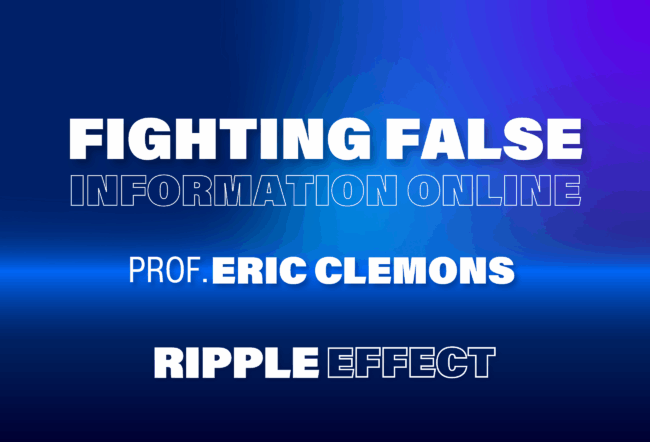Each January, Apple CEO Steve Jobs takes the stage at San Francisco’s Moscone Center for the MacWorld conference’s keynote presentation. Rumors often fly weeks in advance as industry pundits and Apple fans alike speculate on what, if any, new products the company will unveil. Apple typically keeps its product plans tightly-held secrets until Jobs announces them with great flourish at industry events or carefully staged corporate presentations. In many instances, the product is ready to ship the day he announces it. Not so with all companies. Some — Microsoft comes to mind — present technology demonstrations of products that may not be released for months or even years in the future.
Which approach is best? It depends — on the product, the company and its position in the market, say experts at Wharton.
“It’s not a clear-cut situation,” says Wharton marketing professor Jehoshua Eliashberg. “In pre-announcing, a company lets a competitor know what it’s up to. But what matters more is a company’s position in an industry. If a company is a dominant monopolist, it has reason to pre-announce because it doesn’t fear a competitive reaction. If the company is smaller, the negatives of announcing a product early outnumber the positives.”
Marketing professor Christophe Van den Bulte agrees, but notes there are many variables to consider, including audience, dependence on partners and consumer buying cycle. One rule of thumb is based on product classification. If a product is a durable good — something that lasts a few years — a pre-announcement can make sense because the buying cycle is longer. If a product is a consumable that’s easily replaced, product plans should usually be kept secret.
For instance, Van den Bulte points out that durable products which are more expensive and require greater customer commitment are typically announced early. Sony announced its PlayStation 3 well in advance of its launch because it needed a bevy of partners to line up behind the product, including software developers to create games for PlayStation 3 and retailers prepared for the demand. “And of course Sony wanted PlayStation 2 owners to wait for the PlayStation 3” rather than switch to a competitive product, says Van den Bulte. “The company wanted customers to be locked into [the PlayStation platform] between the announcement and launch.”
Overall, pre-announcing products is a practice often followed by industry leaders. According to research by Michigan State University marketing professor Kim Schatzel and Roger Calantone, director of Michigan State’s Eli Broad Information Technology Management Program, companies that pre-announce products tend to be bellwether companies because they have more “competitive equity.” These firms announce products early to steer an industry’s direction, get support for their ideas and promote future plans.
The Schatzel-Calantone study highlights eight hypotheses explaining the effect that pre-announcements have on communication and market anticipation. Pre-announcements, for example, create a cycle where companies can outline their plans to suppliers, distributors, partners and customers, build anticipation and gain brand equity. Pre-announcements can also fuel financial returns. One example cited in the paper involved the expectations surrounding the BMW MiniCooper. “Market anticipation was great and enabled BMW dealers to require substantial prepurchase deposits from prospective buyers to ‘hold’ vehicles — sight unseen — for many months prior to the MiniCooper’s actual introduction,” write Schatzel and Calantone.
Yet according to Wharton marketing professor John Wesley Hutchinson, pre-announcements by themselves aren’t likely to lead to success. They are just one tool in a marketing strategy and are designed to go along with public relations. “Pre-announcements can be free advertising if they are viewed as news. In most situations, the goal is to build awareness as fast as you can.”
Freezing 0ut Competitors
What’s notable about several recent product announcements — such as Microsoft’s unveiling of its interactive touch-screen table technology called Surface Computing on May 29 and Apple’s planned launch of its iPhone on June 29 — is how each company seems to be taking a page from the other’s playbook. Apple, for example, is pre-announcing more products — a rare strategy until recently — while Microsoft, which historically has demonstrated new technologies early, is being more secretive about its products.
Kendall Whitehouse, senior director of IT at Wharton, notes that Apple announced the iPhone, the company’s entry into the “smart phone” market, six months in advance. “Apple clearly wanted to tell people thinking about buying a cell phone in the next few months that they should wait for the iPhone,” says Whitehouse. The company was in effect “freezing the market. The strategy here makes sense.”
Some consumers are obliging. “Companies want to create a commitment in the consumer’s mind,” says Van den Bulte. “By announcing in January, Apple has enticed some people to wait for the iPhone. One [of my] colleagues lost his Treo [a smart phone by Palm]. Instead of buying a new one, he is using his old phone because he knows he is going to get an iPhone.”
Historically, Apple has kept product plans quiet without leaking many — if any — details about them until CEO Steve Jobs sees fit, usually at an Apple conference or event. The iPod was announced suddenly in 2001 and became a runaway hit. The strength of industry-leading products like the iPod may allow Apple to be more aggressive about its iPhone plans. “If you are the top dog, you pre-announce to make competitors less aggressive,” says Van den Bulte, adding that lesser rivals may even scrap products based on an announcement. “Had the iPod not been a tremendous success, the iPhone may have had a different launch strategy.”
Wharton marketing professor Leonard Lodish says that Apple also had to pre-announce the iPhone because there are multiple parties needed to make the product a success. The iPhone had to be approved by the Federal Communications Commission; it needed a wireless carrier such as AT&T; and it had to line up suppliers and manufacturers to produce the iPhone and procure parts.
Other products that similarly need many partners have also been pre-announced, such as Microsoft’s Vista operating system, which was made public years in advance to line up software developers, retailers and PC makers. Whitehouse points out that it’s particularly key to get customers engaged in forthcoming products that seek to serve as a broadly used “platform” upon which other products or applications are built, like Microsoft’s Vista or Adobe’s forthcoming AIR (formerly “Apollo”).
Indeed, in a recent Knowledge at Wharton interview, Adobe Systems president and chief operating officer Shantanu Narayen underscored the importance of getting the community of developers involved in the company’s products before they are widely released. “Being transparent about our plans enables us to get better feedback so that we can deliver better solutions to our customers. With [AIR], we’re targeting the developer community. And with Lightroom we did a public beta very early in the process to get customers to try the software and give us feedback.”
But Narayen also emphasized that early announcement can be a double-edged sword. “When we pre-announce products, sometimes people tend to stall their purchases because they’re aware there’s a new product [coming out]. So there has to be a balance. In retrospect, maybe announcing something nine months ahead of schedule — [like] when we said Creative Suite is going to ship in the second quarter — might have been a little premature.”
For its part, Apple seems to be carving out a hybrid approach — pre-announcing a product but also building buzz by keeping the details secret. While the company announced the iPhone in January, few outside Apple have actually seen the product in action. “No one has been able to see anything more than Apple wants you to see,” says Lodish. “[The product launch] is a theatrical production.”
Microsoft, which has been the poster child for announcing products well before they launch, is now taking a different approach in certain markets. In software, it appears that Microsoft will stick to the status quo and announce its product plans well in advance. With products that move the company into new markets like the Zune music player, the company is more secretive because it doesn’t have a dominant position. Before it announced its Surface Computing products, which are designed for public environments such as hotels and bars, Microsoft kept the effort quiet. In markets where the company is an underdog — such as entertainment devices and online advertising — it also appears to keep product plans quiet, say experts at Wharton.
The Surface Computing technology is different. Microsoft was in the role of a start-up, according to Van den Bulte. There was no need to announce the product early given there is not yet any mass market — or clear rivals. When Microsoft announced it Surface Computing, CEO Steve Ballmer acknowledged that mass market adoption would take a while. “We see this as a multibillion dollar category, and we envision a time when surface computing technologies will be pervasive, from tabletops and counters to the hallway mirror. Surface is the first step in realizing that vision,” said Ballmer in Microsoft’s May 29 announcement.
However, Hutchinson says new product categories don’t have to stay secret. Indeed, pre-announcing new innovations can make sense to prepare consumers to eventually buy them. “True innovation often requires a pre-announcement,” he notes.
What Can Go Wrong
No marketing approach guarantees success if a new product can’t live up to expectations or already faces competition. In Apple’s case, rival phone makers, such as HTC and Samsung, already have touch-screen devices similar to the iPhone. Another risk is that pre-announcing a product can cannibalize a company’s existing sales. For example, Piper Jaffray analyst Gene Munster said in a research note on June 7 that he expects iPhone sales to reduce iPod sales slightly.
Eliashberg, however, doesn’t expect the iPhone to face many problems since it represents a new category for smart phones. “The iPhone is so unique that I don’t see it competing directly with other cell phones. When you start your own category, you can make a pre-announcement and benefit from the early positioning.”
Wharton experts agree that one of the biggest risks to product launches is lofty expectations. Since Apple announced the iPhone, expectations for it have grown dramatically. Munster predicts that Apple will sell 45 million iPhones in 2009, although Apple hasn’t projected sales that far out. The company did confirm on its January earnings conference call that it expects to ship 10 million iPhones in 2008.
At the same time, Eliashberg suggests that high expectations could put a damper on the iPhone launch. “The biggest mistake I have seen is when companies overestimate or underestimate the size of market. There’s a lot of noise evaluating the outcome. If the market size is overestimated, then the product will look like a failure,” he says, adding that the disparity in iPhone shipment estimates “opens the door for disagreement about iPhone’s success.”
Indeed, Palm took hits from a number of industry analysts when on May 29 it announced a new product called the Foleo, a “smart phone companion device” to complement the company’s Treo handheld. While Palm kept the device largely secret, Palm founder Jeff Hawkins had been dropping hints that a big announcement would be forthcoming and the company issued a statement on May 29 indicating that it would unveil a “new category of mobile device.” Such posturing raised expectations for the product. But when the Foleo was introduced on May 30, the response from many industry analysts was tepid. In a research note, Morgan Keegan analyst Tavis McCourt described the Foleo as “somewhat underwhelming.” Gartner analyst Todd Kort was quoted in various press reports calling the Foleo the most disappointing product launch of 2007.
While Jonathan Hoopes, an analyst at ThinkEquity Partners, was more charitable, noting that “the Foleo is two to three years ahead of its time,” some commentators believe the buildup may have helped to undermine the announcement. “It’s great to build up buzz” before the official product unveiling, notes Wharton’s Whitehouse, “but if you then under-deliver, you’re in worse shape than if you had played it more low key.” In Whitehouse’s view, the fact that Hawkins has such a strong reputation for product innovation may have exacerbated the situation. “Hawkins has already defined two major new product categories with the original PalmPilot and the Treo smart phone. People were expecting a third product that was equally as innovative. A clever little ultra-light laptop just didn’t meet those expectations.”
Indeed, according to experts at Wharton, the big lesson is that over time, the product matters a lot more than the marketing strategy — or its initial splash. Microsoft’s Windows 95 product launch is generally considered to have been a big success. But Lodish and Eliashberg aren’t high on Vista, even though the marketing strategy was similar. “I don’t think the product is superior enough to the existing product [Windows XP],” says Eliashberg. “The issue isn’t marketing strategy. It’s the product. If the product isn’t there, marketing won’t help.”



